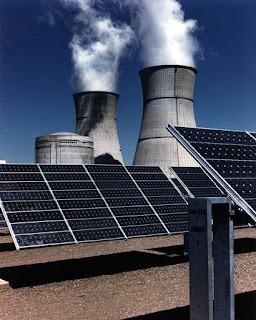How great would it be if someone paid YOU to consume their
goods or use their service? For instance, what if instead of having to pay to
go see a new hit movie, you not only got into the theater for free, but were
even given a few dollars in compensation?
 |
People love to complain about their power bills being too high,
but what if you actually got paid for using power!?
(Photo credit: Max Pixel)
|
This is exactly what would occur if prices were negative for a good, but it’s a fairly rare occurrence. Why? For most goods, the Supply curve doesn’t cross below zero (or even marginal cost (or even minimum average cost for a given firm)). This means that even in the most competitive markets, suppliers are free to either leave the market or just not sell their goods to you, if they can’t get a high enough price to make selling them worthwhile. A negative price doesn’t usually satisfy this condition, so you may wonder if it is ever something we would observe in a real-life marketplace.
 |
It would be unexpected for movie theaters to pay
consumers to go see new blockbuster films.
(Photo credit: LuisJ3000 via Wikimedia Commons)
|
As it turns out, we do observe negative prices for goods
from time to time. As you may have guessed from the title of this article
(unless you were thrown off by the Seinfeld reference), the market for
electricity will at times end up supplying electricity for negative prices. A
few unique characteristics of this market lead to such an occurrence. These
characteristics include:
- The inability to store the good for long periods of time
- Markets that are often segmented and closed-off from other parts of the country
- Varying levels of subsidy to different types of electricity generation
- The impracticality of shutting down or scaling back electricity generating operations for short time-periods
When considering all of these peculiarities together, it is
not surprising that at times more electricity will be generated than people
want to consume, resulting in a negative price. What is most interesting,
however, is how fittingly electricity generation provides a “powerful” example
of how there are always two sides to a market.
I first learned of the negative prices in this market while
reading an article in 2015. At the time, it was fascinating to see prices below $0 for
a good, but for the particular scenario described it was easy to figure out why
it had occurred. In this instance, the supply of electricity in the short-run
was relatively fixed and inelastic (due to the reasons outlined in the bullets
above). As such, and price changes would likely come about due to shifts in
demand. This was exactly the case. During periods of extremely low demand for
electricity, the inability to store or substantially reduce the production of
electricity at low cost meant it was cheaper to take a loss by selling it for a
few hours at a negative price than it would have been to completely stop
generating power.
What made this story even more interesting, is when I came
across this article recently discussing the upcoming total solar eclipse. The article
is all about how the eclipse is a very rare event, but will still have a large
impact on the amount of power being generated that day, due to the drop in
ability of solar panels to convert the sun’s rays to energy. What I found most
interesting in this article, is the following:
“The onslaught of wind
and solar resources is already regularly contributing to wild swings in power
supplies across grids, sending wholesale electricity prices below zero on some
days.”
I was struck by this particular sentence, because it is
describing negative prices in the electricity market for completely different
reasons than the article discussed above. That is to say, even if demand is
stable, the type of technology used to produce and supply power (e.g. renewable
energy sources like solar and wind) can have such inherent variability in productive
capacity that supply can shift in substantial ways. In this case, it is the
supply-side of the electricity market that is sometimes leading to negative
prices.
The important takeaway from all of this is that there are two sides to a market, and it is the unique characteristics of the market you are looking at in space and time that will determine the degree to which supply and demand work together to determine prices. People often have the tendency to focus on one or the other, but it’s best to remember to stay “plugged-in” to information about both.
No comments:
Post a Comment